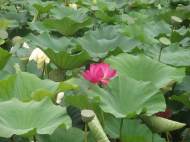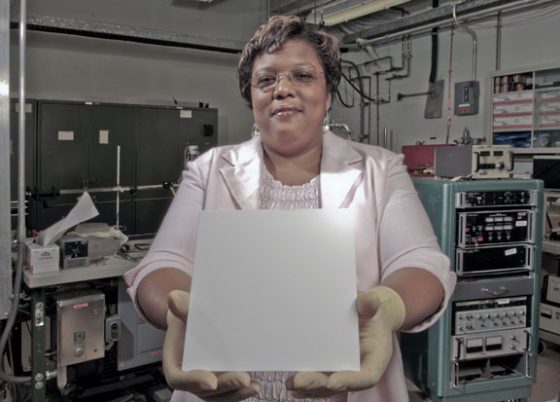Lotus flower biomimicry for dirt and bacteria free surfaces
 Researchers at NASA’s Goddard Space Flight Center in Greenbelt, Md., are developing a transparent coating that prevents dirt and even bacteria from sticking in the same way a lotus plant sheds water. The research begun through collaboration of Northrop Grumman Electronics Systems, Linthicum, Md., and nGimat Corporation, Atlanta, Ga. Although a lotus leaf appears smooth, under a microscope, its surface contains a very large number of tiny spikes that greatly reduce the area on which water and dirt can attach. Unlike a similar research described in one of our previous articles, this one differs in application and features since it has addition of bacteria-killing biocide.
Researchers at NASA’s Goddard Space Flight Center in Greenbelt, Md., are developing a transparent coating that prevents dirt and even bacteria from sticking in the same way a lotus plant sheds water. The research begun through collaboration of Northrop Grumman Electronics Systems, Linthicum, Md., and nGimat Corporation, Atlanta, Ga. Although a lotus leaf appears smooth, under a microscope, its surface contains a very large number of tiny spikes that greatly reduce the area on which water and dirt can attach. Unlike a similar research described in one of our previous articles, this one differs in application and features since it has addition of bacteria-killing biocide.
The NASA team is attempting to mimic this special quality in order to prevent dirt from accumulating on the surfaces of spacesuits, scientific instruments, robotic rovers, solar array panels and other hardware used to gather scientific data or carry out exploratory activities on other objects in the solar system.
The coating was originally developed to reduce the need for window cleaning. Made from silica, zinc oxide, and other oxides, it has a vast range of potential uses on Earth. It could be applied to car windshields, camera lenses, and eyeglasses. It could be applied to solar panels and radiators as well, where cleanliness keeps them operating at their maximum potential. Understanding the potential, Northrop Grumman teamed with nGimat to find more applications for the coating technology. The pair ultimately turned to Goddard for its expertise in making equipment ready to endure the harsh space environment.
“Indeed, the ability to replicate these properties could prove invaluable to NASA,” said Wanda Peters, Principal Investigator for NASA’s lotus coating research and Lead of Goddard’s Coatings Engineering Group. During the Apollo moonwalks, for example, such a technology could have prevented the highly abrasive lunar dust from adhering to astronauts’ spacesuits.
The Goddard team has experimented with and tested different formulas to determine their suitability for spaceflight. “No one formula will meet all our needs,” added Peters. “For example, the coating that’s applied to spacesuits needs to stick to a flexible surface, while a coating developed to protect moving parts needs to be exceptionally durable to resist wear and tear.”
The team partnered with Northrop Grumman in order to add a biocide to the coating, which would kill bacteria that thrive and produce foul odors wherever people are confined to a small space for long periods, like the space station. NASA could apply the same biocide-infused coating on a planetary lander to prevent Earth-borne bacteria from adhering and potentially contaminating the surface of an extraterrestrial object. The team believes this version of the coating may have commercial interest to hospitals as well.
“We are modifying and testing the formula to ensure it can withstand all the challenges our hardware will encounter — extreme temperatures, ultraviolet radiation, solar wind, and electrostatic charging. Outgassing of the coating also must be addressed for use inside astronauts’ habitation areas,” Peters added. “We also are making sure it remains durable and cleanable in the space environment.”










Looking forward to applications in the cleaning industry.
Using the non-stick nature of water on the Lotus leaves, paper plates have been manufactured so that oil won’t stick to the plates.
Paint on which rain drops won’t stick when painted on surfaces has been developed.
Dr.A.Jagadeesh Nellore (AP), India